Respirators - Wearing a Respirator
On this page
What should you know about fitting a respirator?
Back to topWhen fitting a new respirator, try on several brands and sizes when possible. Different brands will fit slightly differently on your face. You may be asked to talk, move your head/face, or make other movements to determine if the respirator is a good choice for you. You may also be asked to remove facial hair where it interferes with the seal between the respirator and skin.
The fit of your respirator should be evaluated periodically. For example, if you have lost or gained weight or have been fitted with new dentures, the shape of your face may have changed. Therefore, the fit and seal of your respirator may change.
See the OSH Answers document on Respirator Selection for more information.
What should I do before wearing a respirator?
Back to topRespirator users should always:
- Report to your supervisor if there is any reason why you cannot wear your respirator safely (e.g., a change in medical condition, facial hair that may interfere with the seal, etc.)
- Use the respirator and filters/cartridges as assigned. They will have been selected to provide protection from the hazards that are present for that task.
- Check that the respirator is clean and in good condition before each use. Inspect for:
- Condition of the parts (e.g., facepiece, harness, valves, filters, cartridges, etc.) for cracks, tears, holes, distortion or warping.
- Tightness of the connections
- End-of-service life indicator (if present) or shelf-life dates
- Proper functioning of any alarms or other warning systems (if present)
- Know how to determine if the filters have reached their end-of-service ability
- Do not wear any respirator that may be defective. Report concerns immediately to your supervisor.
How do I put on an elastomeric half-facepiece respirator?
Back to topElastomeric facepieces are made of silicone, thermoplastic, or rubber material. One or more filters or cartridges are attached to the facepiece.
Always follow the directions provided by the manufacture and your employer. These instructions describe how to put on a reusable elastomeric half-facepiece. Full face respirators would follow a similar process.
In general, adjust the straps so that the respirator fits tightly but does not dig into your face or leave red marks on your skin. The respirator should feel snug but comfortable. Straps should be placed under a hard hat or hood. Position the straps correctly – one strap should go above the ears and over the crown of your head, and the other below the ears and around the neck. If the respirator has adjustable straps, tighten or loosen them without removing the respirator.
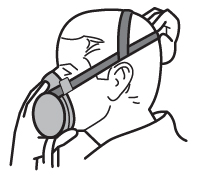
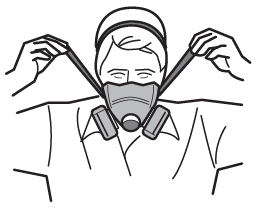
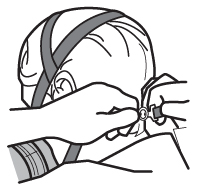
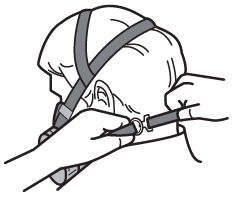
Figure 1: Procedure for putting on a half-facepiece respirator
How do I put on a disposable respirator?
Back to topFiltering facepiece respirators are those respirators in which the entire facepiece acts as the filter. These respirators usually cover half of your face, and are sometimes called "disposable" respirators.
In general, hold the respirator in your hand with the nosepiece near your fingertips. Place the mask over your nose and mouth, and hold with one hand. Using your other hand, pull the top strap over your ears. Pull the bottom strap behind your head and below your ears. If there is a clip, clip it behind your neck. If there is a metal nosepiece, mould it around your nose to create a proper seal.
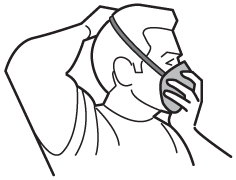
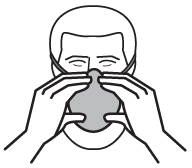
Figure 2: How to put on a disposable respirator
How do I perform seal checks to make sure the mask is adjusted correctly?
Back to topEach time and every time a respirator is worn, you must check that the respirator is sealing properly to the face. Not all respirators will allow the wearer to temporarily block the inlet openings or valves, but these checks should be done whenever possible. Do not wear a respirator that does not seal properly.
Negative pressure seal check: Negative-pressure checks can be done on air-purifying respirators and other respirators with a tight fitting facepiece.
- Put on the respirator.
- Close or block the inlet opening(s) of the respirator so that when you inhale (breath in), no air enters the facepiece.
- Gently inhale, and hold your breath for at least 5 seconds.
- The facepiece should collapse (“squish in”) slightly on your face.
- If the facepiece remains collapsed while you hold your breath, the seal check is successful.
- If the facepiece does not remain collapsed, check that nothing is obstructing (blocking) the sealing surface, adjust the facepiece and harness, and repeat the user seal check.
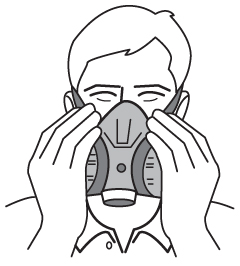
Figure 3: Negative pressure fit check
Positive pressure seal check: Positive-pressure seal checks can be done with respirators equipped with tight-fitting facepieces that have both inhalation and exhalation valves.
- Put on the respirator.
- Close or block the exhalation valve or breathing tube, or both.
- Exhale (breath out) gently.
- The respirator should expand (“puff out”) slightly.
- If a slight positive pressure can be maintained inside the facepiece without noticing any air leaking for 5 seconds, the seal check is successful.
- If a slight positive pressure does not occur, check that nothing is obstructing (blocking) the sealing surface, adjust the facepiece and harness, and repeat the user seal check.
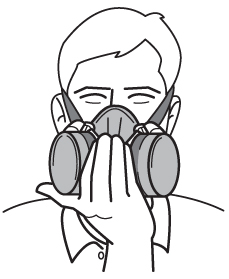
Figure 4: Positive pressure fit check
Seal checks for disposable respirators: A seal check can be done by placing both hands over the respirator itself, or by using a device provided by the manufacturer.
- Put on the respirator.
- Place both hands over the respirator. If there is a valve, block the valve with your hand.
- Breathe in and out.
- If you have a good seal, the facepiece should collapse slightly when you inhale.
- As you exhale, you should not feel air leaking out.
- If you have air leaks, check that nothing is obstructing (blocking) the sealing surface, adjust the noise piece or straps, and repeat the user seal check.
Again, do not wear a respirator that cannot pass the seal checks successfully.
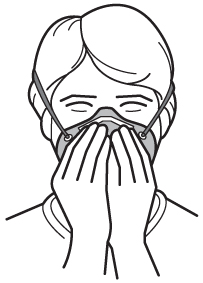
Figure 5: Seal check with a disposable respirator
- Fact sheet first published: 2017-07-11
- Fact sheet confirmed current: 2022-01-25
- Fact sheet last revised: 2017-07-11

